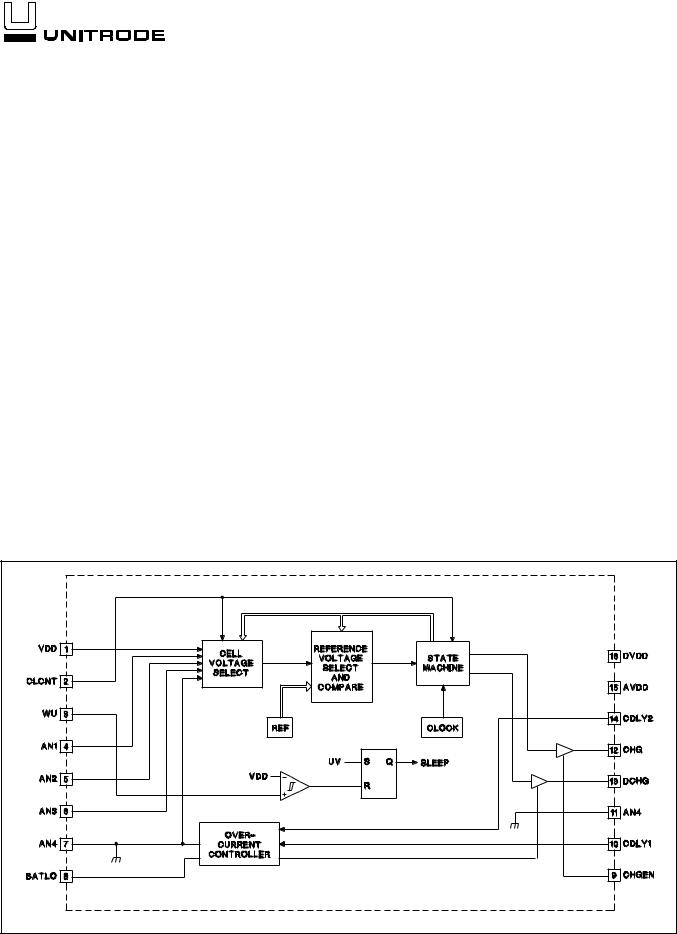Texas Instruments UCC3957MTR-3, UCC3957MTR-2, UCC3957MTR-1, UCC3957M-3, UCC3957M-2 Datasheet
...
UCC3957 -1/-2/-3/-4
PRELIMINARY
Three - Four Cell Lithium-Ion Protector Circuit
FEATURES
∙Three or Four Cell Operation
∙Two Tier Overcurrent Limiting
∙30μA Typical Supply Current Consumption
∙3.5μA Typical Supply Current in Sleep Mode
∙Smart Discharge Minimizes Losses in Overcharge Mode
∙6.5V to 20V VDD Supply Range
∙Highly Accurate Internal Voltage Reference
∙Externally Adjustable Delays in Overcurrent Controller
∙Detection of Loss of Cell Sense Connections
DESCRIPTION
The UCC3957 is a BiCMOS three or four cell lithium-ion battery pack protector designed to operate with external P-channel MOSFETs. Utilizing external P-channel MOSFETs provides the benefits of no loss of system ground in an overdischarge state, and protects the IC as well as battery cells from damage during an overcharge state. An internal state machine runs continuously to protect each lithium-ion cell from overcharge and overdischarge. A separate overcurrent protection block protects the battery pack from excessive discharge currents.
If any cell voltage exceeds the overvoltage threshold, the appropriate external P-channel MOSFET is turned off, preventing further charge current. An external N-channel MOSFET is required to level shift to this high side P-channel MOSFET. Discharge current can still flow through the second PFET. Likewise, if any cell voltage falls below the undervoltage limit, the second P-channel MOSFET is turned off and only charge current is allowed. Such a cell voltage condition will cause the chip to go into low power sleep mode. Attempting to charge the battery pack will wake up the chip. A cell count pin (CLCNT) is provided to program the IC for three or four cell operations.
A two tiered overcurrent controller and external current shunt protect the battery pack from excessive discharge currents. If the first overcurrent threshold level is exceeded, an internal timing circuit charges an external capacitor to provide a user programmable blanking time.
(continued)
BLOCK DIAGRAM
UDG-97060 |
SLUS236 - JANUARY 1999 |

ABSOLUTE MAXIMUM RATINGS
Supply Voltage . . . . . . . . . . . . . . . . . . . . . . . . . . . . . . . . . . 20V Supply Current . . . . . . . . . . . . . . . . . . . . . . . . . . . . . . . . . 25mA Output Current (CHG, DCHG) . . . . . . . . . . . . . . . . . . . . . 25mA WU Input Voltage . . . . . . . . . . . . . . . . . . . . . . . . . . . . . . . . 28V BATLO Input Voltage . . . . . . . . . . . . . . . . . . . . . . –0.3V to 2.5V AN1 and AN3 Input Voltage . . . . . . . . . . . . . . . . . VAN4 – VDD CLCNT and CHGEN . . . . . . . . . . . . . . . . . . . . . . . VAN4 – VDD Storage Temperature . . . . . . . . . . . . . . . . . . . –65°C to +150°C Junction Temperature. . . . . . . . . . . . . . . . . . . –55°C to +150°C Lead Temperature (Soldering, 10 sec.) . . . . . . . . . . . . . +300°C
Unless otherwise indicated, voltages are referenced to AN4. Currents are positive into, negative out of the specified terminal. Consult Packaging Section of Databook for thermal limitations and considerations of packages.
UCC3957 -1/-2/-3/-4
CONNECTION DIAGRAM
SSOP-16 (Top View)
M Package
VDD |
|
|
|
|
|
|
DVDD |
1 |
|
|
|
|
16 |
||
|
|
|
|
|
|
|
AVDD |
|
|
|
|
|
|
|
|
CLCNT |
2 |
|
|
|
|
15 |
|
WU |
|
|
|
|
|
|
CDLY2 |
|
|
|
|
|
|
||
3 |
|
|
|
|
14 |
||
|
|
|
|
|
|
|
DCHG |
|
|
|
|
|
|
|
|
AN1 |
4 |
|
|
|
|
13 |
|
|
|
|
|
|
|
|
CHG |
|
|
|
|
|
|
|
|
AN2 |
5 |
|
|
|
|
12 |
|
AN3 |
|
|
|
|
|
|
AN4 |
|
|
|
|
|
|
||
6 |
|
|
|
|
11 |
||
AN4 |
|
|
|
|
|
|
CDLY1 |
|
|
|
|
|
|
||
7 |
|
|
|
|
10 |
||
BATLO |
|
|
|
|
|
|
CHGEN |
|
|
|
|
|
|
||
8 |
|
|
|
|
9 |
||
|
|
|
|
|
|
|
|
|
|
|
|
|
|
|
|
DESCRIPTION (continued)
If at the end of the blanking time the overcurrent condition still exists, the external discharge FET is turned off for a period 17 times longer than the first blanking period, and then the discharge FET is turned back on. If at any time a second higher overcurrent threshold is ex-
ceeded for more than a user programmable time, the discharge FET is turned off, and will remain off for the same period as the first tier off time. This two tiered overcurrent protection scheme allows for charging capacitive loads while retaining effective short circuit protection.
ELECTRICAL CHARACTERISTICS: Unless otherwise specified, VDD = 16V and –20°C < T A < 70°C, T A = TJ. All voltages measured with respect to the AN4 terminal.
PARAMETER |
TEST CONDITIONS |
MIN |
TYP |
MAX |
UNITS |
Supply Section |
|
|
|
|
|
Minimum VDD |
|
|
5.0 |
5.5 |
V |
Supply Current |
|
|
30 |
40 |
μA |
Sleep Mode Supply Current |
VDD = 10.4V |
|
3.5 |
7.5 |
μA |
Output Section |
|
|
|
|
|
DCHG Output Current |
Driving Logic Low and VO = 1V |
40 |
70 |
100 |
μA |
|
Driving Logic High and VO = VDD – 1 |
–20 |
–7 |
–3 |
mA |
CHG Ouput Current |
Driving Logic Low and VO = 1V |
40 |
70 |
100 |
μA |
|
Driving Logic High and VO = VDD – 1V |
–20 |
–7 |
–3 |
mA |
State Transitions |
|
|
|
|
|
Normal to Overcharge |
UCC3957-1 |
4.15 |
4.20 |
4.25 |
V |
Overcharge to Normal |
UCC3957-1 |
3.95 |
4.00 |
4.05 |
V |
Normal to Overcharge |
UCC3957-2 |
4.20 |
4.25 |
4.30 |
V |
Overcharge to Normal |
UCC3957-2 |
4.00 |
4.05 |
4.10 |
V |
Normal to Overcharge |
UCC3957-3 |
4.25 |
4.30 |
4.35 |
V |
Overcharge to Normal |
UCC3957-3 |
4.05 |
4.10 |
4.15 |
V |
Normal to Overcharge |
UCC3957-4 |
4.30 |
4.35 |
4.40 |
V |
Overcharge to Normal |
UCC3957-4 |
4.10 |
4.15 |
4.20 |
V |
Undercharge to Normal |
|
2.5 |
2.6 |
2.7 |
V |
Normal to Undercharge |
|
2.2 |
2.3 |
2.4 |
V |
OV to CHG Delay |
(Note 1) |
10 |
17 |
23 |
ms |
2
UCC3957 -1/-2/-3/-4
ELECTRICAL CHARACTERISTICS: Unless otherwise specified, VDD = 16V and –20°C < T A < 70°C, T A = TJ. All voltages measured with respect to the AN4 terminal.
PARAMETER |
TEST CONDITIONS |
MIN |
TYP |
MAX |
UNITS |
State Transitions (continued) |
|
|
|
|
|
UV to DCHG Delay |
(Note 1) |
10 |
17 |
23 |
ms |
Cell Sample Rate |
(Note 1) |
5 |
8.5 |
11.5 |
ms |
Smart Discharge Threshold |
BATLO Voltage |
12 |
15 |
20 |
mV |
Wakeup Input Threshold |
With Respect to VDD |
50 |
|
|
mV |
Charge Enable Input Threshold |
|
0.8 |
1.3 |
2.6 |
V |
Short Circuit Protection |
|
|
|
|
|
First Tier Threshold Level |
VBATLO |
120 |
150 |
180 |
mV |
Second Tier Threshold Level |
VBATLO |
300 |
375 |
450 |
mV |
First Tier Blanking Time |
CDLY1 = 0.1μF |
30 |
50 |
70 |
ms |
Restart Time |
CDLY1 = 0.1μF |
300 |
500 |
700 |
ms |
Second Tier Blanking Time |
CDLY2 = 10pF |
200 |
400 |
550 |
μs |
Note 1: Tested at probe only.
Note 2: Other OV/UV thresholds are available. Please consult the factory.
PIN DESCRIPTIONS
AN1: Connects to the negative terminal of the top battery cell and the positive terminal of the second battery cell.
AN2: Connects to the bottom terminal of the second battery cell and the top terminal of the third battery cell.
AN3: Connects to the bottom terminal of the third battery cell and the top terminal of the fourth battery cell in a four cell stack. In a three cell pack it connects to the bottom terminal of the third battery and to AN4.
AN4: Connects to the bottom terminal of the battery stack and the top of the current sense resistor.
AVDD: Internal analog supply bypass cap pin. Connect a 0.1μF capacitor between this pin and AN4. This pin is nominally 7.3V.
BATLO: Connects to the bottom of the current sense resistor and the negative terminal of the battery pack.
CHGEN: The charge enable input for the protection IC. This point must be driven high to allow charging of the battery pack. This pin has a very weak pulldown.
CDLY1: Delay control pin for the short circuit protection feature. A capacitor connected between this point and AN4 will determine the time delay from when an overcurrent situation is detected to when the FET is turned off. This capacitor also controls the hiccup mode timeout period.
CDLY2: An external cap can be tied between this pin and AN4 to extend the blanking time on the second current limit tier.
CLCNT: This pin programs the IC for three or four cell operation. Tying this pin low (to AN4) sets four cell operation, w`hile tying it high (to VDD or the preferred DSPLY or ASPLY) sets three cell operation. This pin is internally pulled low, so open circuit conditions will always result in four cell mode.
DCHG: This pin is used to prevent overdischarge. If the state machine indicates that any cell is undervoltage, this pin will be driven high with respect to chip substrate so that the external P-channel MOSFET will prevent further discharge. If all cell voltages are above the minimum threshold, this pin will be driven low.
CHG: This pin is used to control an external N-channel MOSFET, which in turn drives a P-channel MOSFET. If at least one cell voltage is over the OV threshold, this pin will be driven low with respect to AN4. If all cell voltages are below this threshold, this pin will be driven high.
DVDD: Internal digital supply bypass capacitor pin. Connect a 0.1μF capacitor between this pin and AN4. This pin is nominally 7.3V.
VDD: Supply voltage to the IC. Connect this point to the top of the lithium-ion battery stack.
WU: This pin is used to provide a wake up signal to the IC during sleep mode. Connect this pin to the drain of the N-channel level shift MOSFET.
3
